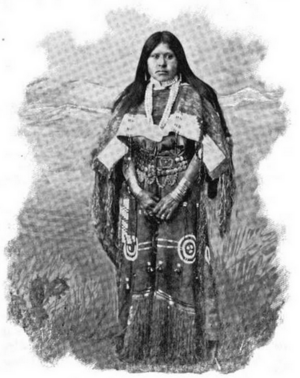Shawsheen facts for kids
Quick facts for kids
Shawsheen
|
|
|---|---|

This photo was once thought to be Chipeta. It is actually Shawsheen.
|
|
| Born | 1845 |
| Nationality | Native American |
Shawsheen (also known as Shoshine, She-towitch, or Susan) was a brave and important Native American woman. She was part of the Tabeguache (Uncompahgre) Ute tribe. Shawsheen was also the sister of the famous Chief Ouray.
She is remembered for a few key things. In 1860 or 1861, she was captured by the Cheyenne and Arapaho. Later, she protected and cared for Arvilla and Josephine Meeker when they were also held captive. Shawsheen was also a strong female leader in her tribe. She worked alongside her sister-in-law, Chipeta, to help guide her people.
Shawsheen's Early Life
Shawsheen was born around 1845. She was likely born in Colorado or northern New Mexico. Most historians believe she grew up in the Uncompahgre Valley. Like many young Ute girls, she learned important skills. These included bead work and weaving. These crafts were used for trading with other Native Americans and settlers.
Her Marriage to Chief Johnson
Shawsheen married Chief Johnson 2, also called Canalla. He was a White River Ute. Her father, Guero, arranged this marriage. It was meant to improve relations between the Northern Utes and the Tabeguache Utes. After her marriage, Shawsheen moved from the Uncompahgre Valley. She went to live with her new family on the White River.
Captured by Other Tribes
Around 1860 or 1861, Shawsheen was hunting. She was near the Cache la Poudre River in Colorado. There, she and her family met members of the Cheyenne and Arapaho tribe. During a fight, Shawsheen was taken captive.
Her family told the United States Cavalry. But it took two years for soldiers to find her. Troops from Camp Collins (now Fort Collins) finally located her. Historians say the soldiers found her just as the Cheyenne were about to tie her to a fire. The troops rescued Shawsheen. She then stayed with Simeon Whitley for a few months. He was a former agent for the Ute tribe. After that, she returned home.
Learning English and a New Name
While staying with Simeon Whitley, Shawsheen learned English. She could speak and understand it. Mrs. Collier, whose husband led the soldiers who found Shawsheen, gave her a new name: "Susan." Many historians still call her Susan today.
There are different stories about how Shawsheen escaped. Some historians say she was rescued by the soldiers. But her family's oral traditions say she escaped on her own. During her time as a captive, she was treated like a slave. She was forced to do hard work. This was different from other Native American captivities, where people were sometimes adopted into the family.
Shawsheen's Role in the Meeker Incident
The Meeker Massacre happened on September 29, 1879. It was an attack by some Ute people on an Indian Agency in Meeker. During this event, Nathan Meeker, an Indian Agent, and ten of his workers were killed. His daughter Josephine and wife Arvilla Meeker were taken captive. Other women and children were also captured by the Ute.
After the incident, the Ute met to decide what to do with the captives. Many wanted to harm them. But Shawsheen and her husband strongly argued for their release and safety. Josephine Meeker later said, "We all owe our lives to the sister of Chief Ouray..." The captive women praised Shawsheen for her kindness. They even called her "God Bless Susan." She not only pushed for their release but also kept them safe. After they were freed, the captives wrote about their experiences. Many called for Shawsheen to be recognized for her actions.
A Hero's Legacy
Shawsheen has been called a hero by many people. This includes the Meeker women themselves. Josephine Meeker wrote about Shawsheen in her story. She said, "I may say more, which is that we all owe our lives to the sister of Chief Ouray." Josephine explained how Shawsheen worked for their freedom and kept them safe.
Shawsheen's Many Names
Shawsheen was known by several names throughout history. Her family calls her She-Towitch. Many modern historians use Susan, "Ute Susan," or Shawsheen. She was also called Tsashin, Shosheen, Shashein, and Shasheen in old newspapers or family stories.
Her Lasting Impact
Shawsheen's life and her important actions in early Colorado history are remembered. The Greeley Museums in Greeley, Colorado, recognize her. This organization also takes care of the Meeker Home Museum. This was the original home of the Meeker family. In Greeley, an elementary school is named after her (Shawsheen Elementary). You can also find information about her life and legacy at the Greeley Museum.

